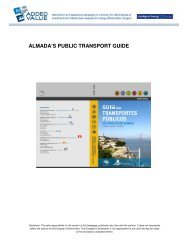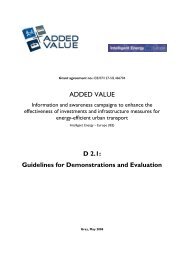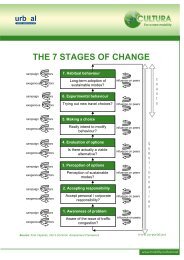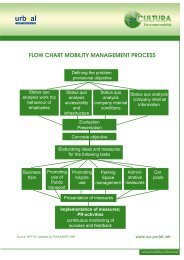SUMO - Eltis
SUMO - Eltis
SUMO - Eltis
Create successful ePaper yourself
Turn your PDF publications into a flip-book with our unique Google optimized e-Paper software.
4<br />
EXAMPLE<br />
48<br />
sumo – Appendix<br />
Target group<br />
The target group for the project’s marketing is business management and employees at the companies<br />
in the industrial park and along the cycle route. The primary target group is employees with up<br />
to 5 km between home and workplace. A target group analysis is carried out at the planning stage of<br />
the project and is described at the analysis level Person-related factors (P).<br />
Target<br />
Examples of targets for combination measures could be:<br />
External factors<br />
External factors that influence the opportunity or interest in cycling to and from work include the<br />
availability of a safe cycle route, parking fees at the workplace, access to public transport (for use<br />
when the weather is poor), and shower and changing room facilities at the workplace. In a comparison<br />
of pre and post data these factors must be known in order to obtain fair results as they could have<br />
either a positive or negative influence.<br />
Person-related factors<br />
Person-related factors are gender, age etc. If the age composition has changed between pre and post<br />
measurements then this can influence results. In a comparison of pre and post data these factors must<br />
be known to obtain fair results.<br />
Indicators for the different analysis levels in <strong>SUMO</strong><br />
A selection of indicators that are interesting to measure is presented below. Positive regional<br />
development and improved urban environment are not measured in the same systematic way as<br />
environmental impact, but have an indirect impact on the system that is described verbally.<br />
LEVEL TARGETS<br />
A<br />
C<br />
F<br />
H<br />
Useful<br />
achievements<br />
Degree of use of<br />
mobility service<br />
Experimental<br />
individual<br />
behaviour<br />
Permanent<br />
individual<br />
behaviour<br />
Construction of an uninterrupted cycle route.<br />
At least 100 persons from companies along the cycle route have participated<br />
in collaborative and information meetings about the planned measures.<br />
At least 100 new cyclists take part in a test project where they agree to<br />
cycle to and from work at least 4 days per week for two months.<br />
At least 75 per cent (75 people) of the new cyclists that have tested the<br />
route continue to use it 12 months after the test period. The number of<br />
cyclists (new and old) on average between the town and the industrial park<br />
increases from 170 per annual average day in 2004 to 240 in 2006.








